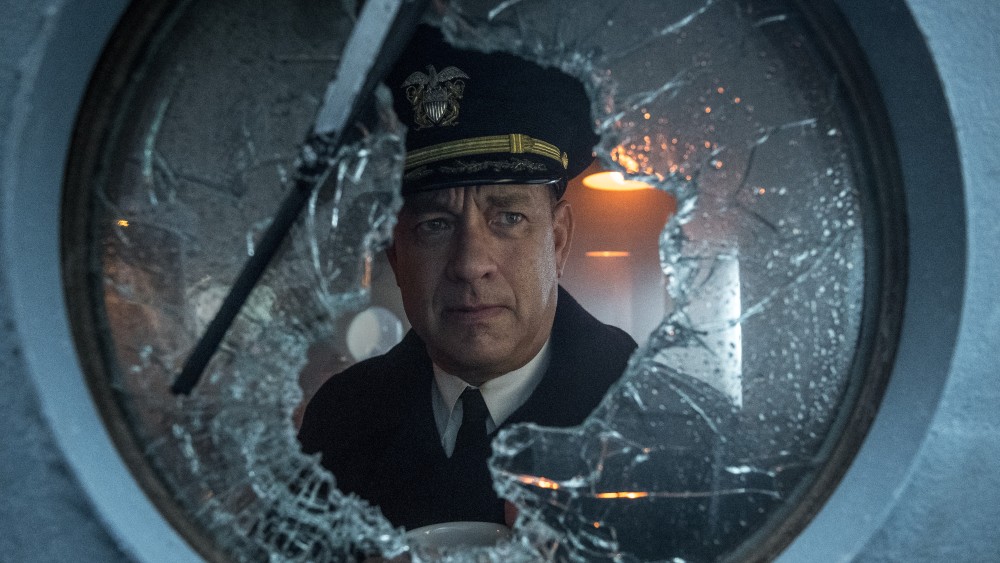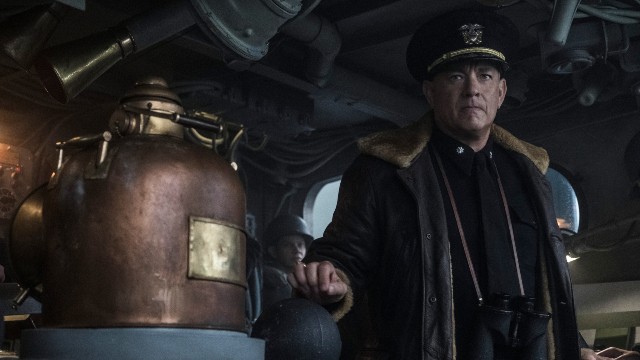
“And the Oscar goes to,” is a familiar phrase we anticipate hearing each year in the 93-year history of the Academy Awards. This year, for the first time in many decades, the Academy of Motion Picture Arts & Sciences has created a new category for “Sound” in their awards extravaganza, merging sound editing and sound mixing into one single category.

The sound team of Greyhound, namely first-time nominee Supervising Sound Editor Warren Shaw (CAS), two-time nominee Re-Recording Mixer Beau Borders (CAS), first-time nominee Production Sound Mixer David Wyman (CAS), and three-time Oscar winner Supervising Sound Editor/Mixer Michael Minkler (CAS) couldn’t be more honored to be among the nominees of the 93rd Academy Awards with that brand new distinction.
For Borders, he’s hoping the second time being nominated is the charm. “You never know if there’s gonna be a third one,” he jokes. “I didn’t know there was gonna be a second one. It’s really great to be nominated in this specific year because after having many confusing years of having two different categories for the sound Oscar contention, to merge them into one as the sound team is really nice to unify us all and the Academy has done a great job of doing that for us. It’s fun to be part of the first year of that.”
For first-time nominees Shaw and Wyman, it couldn’t be more exciting. “How cool is that?!, Wyman exclaimed. “It’s truly humbling. I have to say that the most advantageous thing about being nominated is to be able to unpack all the work that went into this movie. When you start to peel off the layers of this sound onion that is Greyhound, it’s really very ear-opening for everybody concerned and I think that’s one of the true advantages of being nominated.” Shaw added, “This is a movie that’s very complicated in what David had to do and very complicated on my end and Beau’s end and Michael Minkler’s end. It all came together as one and if it came together as a whole and is telling a story to people, that’s awesome.”

The story of Greyhound, which premiered on Apple TV+ in July 2020, was penned by star Tom Hanks, who portrays longtime Navy veteran Captain Krause during World War II. As a first-time captain, he is given the dubious mission to protect a convoy of 37 ships carrying thousands of soldiers with dire supplies across the treacherous waters of the Atlantic known as “the Black Pit.” Wyman did something very special every morning to give Hanks a captain’s welcome to the ship, aside from making sure the dialogue was crystal clear. “I haven’t told anybody about this and nobody who works on the movie knows this.” he revealed, “We would play a song every day when he first stepped onto the Gimbel set after he’d been through hair and make-up before we would roll. It became a challenge to find as many nautical-themed songs as we possibly could. I made the playlist with my crew, and he wouldn’t know what it was. Every morning he’d go, ‘I’m ready for the song,’ and we’d play them over these massive PA speakers that we were using to generate sound effects. It became Name That Tune every morning. That was a true highlight of the camaraderie of all of the guys. People would throw out suggestions. The one that I remember the most was when we moved to the set of the USS KIDD for exteriors of the real ship, I played Proud Mary because the chorus was ‘rolling on a river.’ Then of course Rock The Boat.”
Playing music for Hanks before the cameras rolled was something to lighten the mood compared to the team’s most preeminent tasks, which was to create sounds that were authentic to the 1940s when these actual events occurred. Wyman set out to do just that by researching USS ships for three days, analyzing internal communications of the ship, and making sure everything was pitch-perfect to wartime. “Really what we’re talking about in terms of re-creation was the modification of the original 1940s equipment,” Wyman explained. “The director (Aaron Schneider) was absolutely adamant about all the authenticity. He did not want anything to be on set that was not authentic including all of the props that the actors used. The way the script was laid out and what it called for with all the overlaps and conjoining action that was based upon a set of orders that was being given by Captain Krause meant they had to be a discreet communication system between all of the actors. They had to be able to hear, repeat the orders which went down into a speaker that was maybe on another set that we were filming at the same time. There had to be communication over phones and the actors had to be reading the off-screen lines to the equipment they would’ve used.”
Keeping things authentic wasn’t without many challenges as the team had to compete with the special effects hoping it wouldn’t drown out the sounds they worked so hard to achieve while making it sound as realistic as possible. Wyman offered, “Bearing in mind we had two Ritter fans, massive wind effects, rain effects, mist effects, and all of that on a set that was pitching and yawing just like the motion of a real vessel so several people got seasick on the Gimbel while we were using it! Add to that we’re trying to do the cleanest dialogue recording that we could and make sure our equipment didn’t suffer catastrophic failure because the water and the wind effects could’ve made it unusable. Every time there’s a costume change like a hat goes off and a helmet goes on, there has to be a microphone change but if it happens on screen that means we’re mixing three or four microphones directly on Tom’s body, or switching from one to the other in the middle of the scene. So it was all a very complicated journey.”

With Greyhound, the journey for Shaw began with a lot of research to create the explosive sounds of battle between the U.S. Navy and a German submarine. “We didn’t record the weapons for this movie,” he explained. “If this was a contemporary movie we would’ve rented the guns but these guns don’t exist on that level. So what I started doing at the very beginning was a history project in researching the guns (of the time) and listening to clips from the ’40s of what they sounded like so you could get a sense. Then we deconstructed them and went into our library of hundreds of thousands of little elements and figured out the magic potion and which ones would we put together to create the sound of this gun because authenticity was key.”

While Wyman spends time and effort getting the dialogue as cleanly recorded and pristine as possible without any extra noise on it, it’s up to Borders and Shaw to blow it up. Borders illustrated, “Warren and I come along and just fill it up with a whole bunch of more noise! Which is necessary because you need to feel like the environment just shifted; that you’re in the Radar room vs. the Bridge. We need to sell you this reality because other than the physical sets where you see where the actors are, everything is computer-generated. There was no ship barreling through the water or torpedo in the water. That is all created through visual effects later so the main part of what Warren and I do and our team as well is we try to convince you that what you’re seeing is actually happening when in fact it’s not.”
What the Greyhound sound team was mostly hoping to achieve when all their work was said and done was not only delivering the tension with the crash of a wave or the sound of the emergency horn blowing, but the whole story coming together. Wyman concludes, “The one thing I’m really proud of is “The Battle of the Atlantic” is not a story that has been well told. I couldn’t find any decent movies that really honed in on how harrowing that journey was with a lot of people who lost their lives. To make a movie that encapsulates those emotions, that danger and tells that story is what we’re most proud of.”
Greyhound can be streaming via Apple TV+. The 93rd Academy Awards will be broadcast live on ABC from Union Station Los Angeles and the Dolby Theatre at the Hollywood & Highland Center on April 25, 2021, at 8pm ET/5pm PT.
All photos courtesy Apple.






